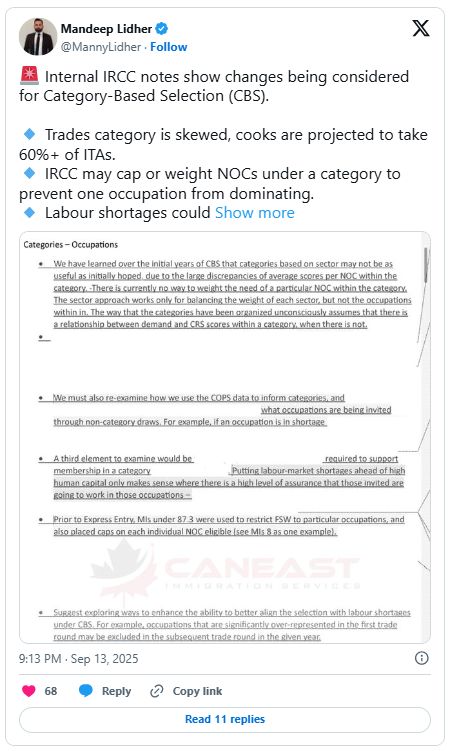- within Immigration topic(s)
- with Senior Company Executives, HR and Finance and Tax Executives
- in European Union
- in European Union
- with readers working within the Automotive, Insurance and Healthcare industries
Immigration, Refugees and Citizenship Canada (IRCC) is reportedly querying how effective the category-based draws are, recently published documents reveal.
ATIP notes, obtained by Mandeep Lidher of Caneast Immigration Services, reveal internal discussions at IRCC highlighting that the category-based draws aren't working as expected or as the immigration department had hoped. In this post, we dig into what's driving the concerns about how the category-based draws are functioning, and whether IRCC will eliminate them.
Key Takeaways
- Internal IRCC documents reveal that the category-based draws aren't working as expected or hoped.
- Future solutions may include 'caps' for overall numbers of invitations going to certain occupations within a category.
What you'll find on this page
Internal Discussions at IRCC about Category-Based Draws
Will IRCC End Category-Based Draws?
Internal Discussions at IRCC about Category-Based Draws
Category-based draws were introduced in 2023 to help Canada attract and retain newcomers with work experience in certain sectors. These sectors are generally experiencing widespread shortages or, at the least, higher expected demand over the coming years.
However, it's not clear that the category-based draws are actually achieving that purpose.
Here's what the IRCC's internal document says:
Text version (emphasis added by us):
- We have learned over the initial years of CBS that categories based on sector may not be as useful as initially hoped, due to the large discrepancies of average scores per NOC within the category. There is currently no way to weight the need of a particular NOC within the category. The sector approach works only for balancing the weight of each sector, but not the occupations within in. The way that the categories have been organized unconsciously assumes that there is a relationship between demand and CRS scores within a category, when there is not.
- We must also re-examine how we use the COPS data to inform categories, and what occupations are being invited through non-category draws. For example, if an occupation is in shortage
- A third element to examine would be ______ required to support membership in a category. Putting labour-market shortages ahead of high human capital only makes sense where there is a high level of assurance that those invited are going to work in those occupations –
- Prior to Express Entry, MIs under 87.3 were used to restrict FSW to particular occupations, and also placed caps on each individual NOC eligible (see MIs 8 as one example).
- Suggest exploring ways to enhance the ability to better align the selection with labour shortages under CBS. For example, occupations that are significantly over-represented in the first trade round may be excluded in the subsequent trade round in the given year.
What's The Actual Issue Here?
We guess, based on IRCC's notes, that the occupations being represented by the category-based draws isn't currently as diverse as IRCC had hoped. This likely means that a handful of occupations are dominating the draws, while others working in those in-demand sectors have been less successful obtaining the high scores needed to qualify, particularly without French.
This was highlighted today in the Toronto Star, which ran an article discussing how a 49-year-old practising family doctor was unable to qualify for even the healthcare rounds in Express Entry with his CRS score. The article notes that he has hundreds of patients in Ontario – a province with a severe shortage of doctors – and he is unable to receive PR.
It goes on to say:
"...immigration data show as of Aug. 11, there were 2,436 general practitioners and family physicians, 170 surgeons and 519 specialists in clinical and laboratory medicine in the Immigration Department's talent pool who have not made the cut."
The reality is that this particular doctor's CRS is 435, which is 35 points lower than the most recent CRS cut-off for a healthcare round. But Ontario and BC are both heavily recruiting in the USA for physicians and nurses, and it may be challenging for Canada to attract and retain that talent if the workers are not able to obtain permanent residence in Canada.
Trades Category Dominated by Cooks
Another example is the overrepresentation of cooks in the trades category. Manny Lidher also reported that around 50-60% of the workers eligible for the trades category-based draws are cooks, and that if a single draw was completed, there would not be much diversity in the occupations invited to apply for permanent residence.
What's the Solution?
Well, that depends on who you ask.
One of Canada's prominent think tanks is opposed to using economic immigration strategies to fill short-term labour shortages. The CD Howe Institute recently noted:
"Immigration policy should raise average human capital, rather than focusing narrowly on filling short-term labour market gaps, which prevents wage increases and capital investment to enhance productivity, or meeting non-economic objectives such as increasing Francophone immigration outside Quebec."
Side note: we tend to agree with them that the Francophone immigration programs being part of the Express Entry economic immigration category doesn't make a great deal of sense (especially in the absence of data showing that these newcomers earn above-average wages). Though, we don't think the Francophone policies should be abandoned, just perhaps moved to a diversity and cultural goals category.
IRCC on the other hand seems to be considering a few options:
- Capping the number of applicants in a category representing a certain occupation. It used to do this prior to the Express Entry system, where eligible occupations were capped at 300 applications in 2013 for the FSW program.
- Excluding certain occupations from category-based draws if they are already over-represented in the number of invitations issued within a set period.
- Adjusting the criteria for eligibility for a category-based draw – for example, requiring certain designations to ensure workers are likely to work in the occupation that's in shortage in Canada.
Though, number three would also likely require some steps to help improve foreign credential recognition for workers in in-demand occupations. There was a really good piece in The Walrus on this topic recently.
Will IRCC End Category-Based Draws?
We don't believe it will in the near term (2026). However, we wouldn't be surprised to see changes coming in to encourage increased representation across in-demand occupations. We also wouldn't be surprised to see some significant changes to the eligible occupations for 2026 category-based rounds. (We saw changes in 2025 too!)
But, IRCC has an unenviable task – allocating finite invitations and approvals each year amid an extremely saturated and competitive pool while provinces and smaller regional towns across Canada beg for more talented workers to fill their shortages.
It's tough knowing that the reality is for every candidate invited, there's an equally deserving, equally hard-working candidate whose dreams to live in Canada permanently are being delayed or potentially destroyed forever.
The content of this article is intended to provide a general guide to the subject matter. Specialist advice should be sought about your specific circumstances.



